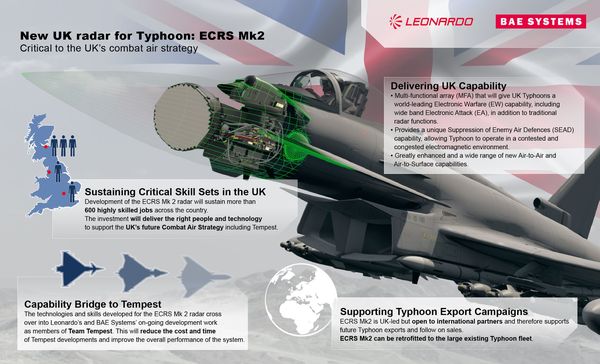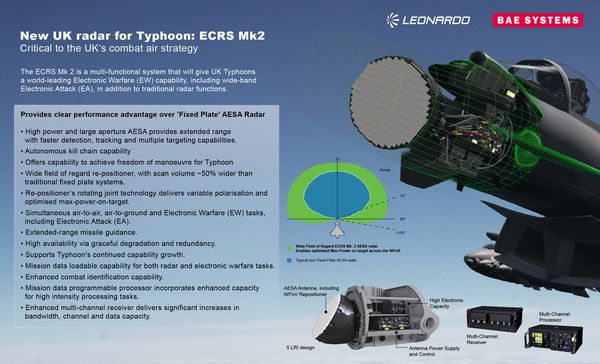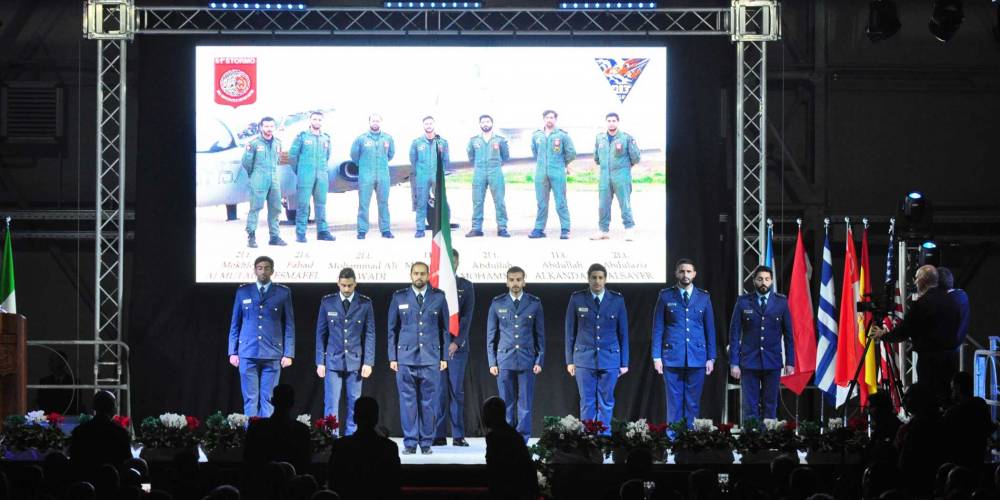Typhoon’s Radar Two breaks cover
On 3 September 2020, UK Defence Minister Jeremy Quin announced that a £317 million contract had been signed covering the integration of a new Active Electronically Scanned Array (AESA or E-Scan) radar on the Typhoon, to meet RAF Requirements.
A test and evaluation contract for the previously little-known ‘Radar Two’ had been widely expected, to allow development of this radar to be completed. In recent months, there have been a number of reports that a test version of the radar was being operated in Leonardo’s roof lab at Crewe Toll in Edinburgh, and even that ‘Radar Two’ formed part of the Eurofighter offering to meet the Finnish HX fighter requirement, and had been demonstrated to Finnish personnel. It was also predicted that a development contract would include the production of five radar sets for flight trials.
While it was expected, the announcement of the contract represents an extremely welcome boost for both industry and the Royal Air Force. It is the product of ten years of MoD investment in UK radar/EW programmes, and while it is not the final step in the journey towards equipping RAF Typhoons with a new radar it is a critical step in the long term air capability plan.
The UK has long resisted pressure to adopt what was once hoped to be a four-nation AESA programme, insisting that the RAF needed a more advanced radar, which would incorporate extensive electronic attack (EA) and electronic warfare (EW) capabilities.
This led to a divergence of AESA radar development for the Eurofighter. The development of the baseline Captor-E AESA radar saw both BAE Systems and Leonardo working alongside Eurofighter consortium partners in Germany, Spain and Italy as part of a four-nation development programme, with Leonardo leading the four-nation EuroRADAR consortium (Leonardo in the UK and Italy, Hensoldt in Germany and Indra in Spain) to develop the baseline E-scan radar, and also acting as the design authority, leading the design of the radar system. BAE Systems had equipment design responsibility, integrating the radar into the aircraft.
The resulting Captor-E was a minimum change version of the M-Scan Captor radar, combining the existing Captor back end with a new AESA antenna, mounted on a dual swashplate repositioner. The first production variant of this new AESA radar was known as Radar One Plus or ECRS Mk 0, and was developed primarily to meet the requirements of Kuwait and Qatar.
Another version of the Captor-E is being developed to meet German and Spanish requirements. Germany has a requirement to retrofit AESA radars to 110 of its Tranche 2 and Tranche 3 Eurofighters, and to equip the 38 new-build aircraft being acquired to replace Tranche 1 aircraft under Project Quadriga. Spain plans to retrofit 19 of its Eurofighters.
Hensoldt was awarded a €1.5 Bn contract by Airbus Defence and Space to develop and produce a new ECRS Mk 1 AESA radar for the German and Spanish Eurofighter fleets. The ECRS Mk 1 is a development of the Kuwait/Qatar standard Mk 0, and will be produced by retrofitting Mk 0 radars with a new digital multi-channel receiver and new transmitter/receiver modules developed by Hensoldt.
Hensoldt will be the design authority for the new Mk 1 radar, drawing on Hensoldt’s years of partnership with Leonardo in producing the current Typhoon radar, while Airbus will have equipment design responsibility for the new variant. Leonardo will provide a significant level of support to enable Hensoldt to assume design authority, and will also continue to provide the processor for the German radar.
Despite UK companies having leadership of the Captor-E project, the baseline Mk 0 radar was never going to be used by the RAF, whose corporate heart was always set on the more capable ‘Radar Two’ product.
The new British radar, known as ECRS Mk 2, is designed to ensure that Typhoon will be able to operate in the most challenging contested environments, on its own, and autonomously. The new radar allows potential export customers to operate a single platform Typhoon fleet even in the most challenging contested environments.
BAE Systems’ former Finland Campaign Manager, Wing Commander Anthony ‘Foxy’ Gregory, explained that ECRS Mk 2 “makes the case for Eurofighter in Finland more compelling.”
Gregory says that Finland has “a predominantly defensive posture against adversaries, and is looking to protect a long land border,” making the HX competition “predominantly a high-end air defence type of requirement, albeit operating in a high threat environment, from the point of view of some of the adversary threat systems that might be deployed.” He says that Typhoon offers advantages over the F-35 in speed, range, and reach, with greater autonomy and sovereignty in Mission Data, and enjoys a similar ability to operate and survive in a contested environment.
For the UK, the new radar also promises to make Typhoon the ideal partner in a fourth/fifth generation and unmanned force mix for decades to come.
It was once believed that leading air forces would move to an all-Stealth, all fifth generation force structure, but the growing vulnerability of stealth to new and developing counter stealth systems, coupled with the high cost, has led to a growing emphasis on operating fourth and fifth generation fighters together in a more complementary and synergistic fashion. This is what lies behind the resurgence of the Block III Super Hornet and Growler, and also the development of Boeing’s Advanced F-15EX.
ECRS Mk 2 promises to allow the Typhoon to enhance the RAF’s F-35 force – not merely carrying additional weapons to the fight, but bringing its own advanced capabilities that improve the F-35’s survivability and effectiveness. A Typhoon equipped with ECRS Mk 2 will be a very survivable platform, so while the enemy may know that the aircraft is ‘in the area’, it will be able to operate as what one programme insider described as a ‘brute squad’, its pilot not having to worry about his signature, able to carry vast numbers of weapons and “raining down electronic attack and the world’s supply of SPEAR Capability III or SDBs or whatever weapon you want to use, while the fifth gen aircraft is acting as a silent assassin, sliding around the back to slip the knife in!”
“This is going to be an asset that people are going to want to have there. Just like they want Growlers now, they’re going to want Typhoon with ECRS Mk 2 because of the things that it’s going to be able to do in the really challenging contested environment, and because of the way it complements and enhances the capability of fifth generation and unmanned platforms. The force mix, the mixture, the combination of Typhoon with ECRS Mk 2 and F-35, is greater than the sum of the parts. Leonardo’s EW division at Luton are literally at the top of the premier league within the EW market, so we’ve got something that genuinely adds capability value, even if you’re operating as part of a coalition with the US.”
In the wake of the contract announcement, more detailed information about the new radar emerged. ECRS Mk 2 has been developed by Leonardo and will be integrated by BAE Systems, the UK’s prime contractor for the Typhoon.
Though designated as the ECRS Mk 2, (European Common Radar System Mk 2), the new UK radar has little in common with previous Euroradar AESA radars, despite sharing the same ECRS designation prefix. The ECRS Mk 0 AESA radar fitted to Kuwaiti and Qatari Typhoons, and the ECRS Mk 1 radar which is being developed for the German/Spanish retrofit programme are derivatives of the mechanically scanned (M-Scan) Captor-C, using much the same back-end, but married to a new AESA array with an innovative double swashplate repositioner. They are collectively known as Captor-E variants.
The ECRS Mk 2 radar does share a common interface with the platform and weapons system, via the German supplied attack computer, and uses the same power generation and cooling, but is not based on Captor technology, instead using a completely new open-architecture radar ‘back end’. From the power supply forward the new radar uses completely new hardware, including what is referred to as a “revolutionary” Multi-Function Array. This will allow the radar to provide traditional air-to-air and air-to-ground, search, track and targeting functions as well as new electronic warfare (EW) and wide-band electronic attack (EA) capabilities.
The open architecture of the back end will also enable the rapid low cost development cycles necessary for the radar to be adapted to counter dynamic and developing threats. The concept is that the whole radar will become what is being called ‘mission ware’, which can be changed with the same level of overhead and difficulty as it now takes to change mission data – crucially without having to go back through the safety case every time the software is changed.
The ECRS Mk 2 also has a completely new processor, a new receiver, a dedicated EW receiver and techniques generator, and a completely different system for the antenna repositioner, using a single rotating joint, rather than the double swashplate arrangement of Captor-E. The aircraft will even feature a new radome to support the wide bandwidth that comes with ECRS Mk 2.
The Typhoon’s relatively wide nose allows it to accommodate a large radar dish, and this in turn allows a large number of transmit-receive modules (TRMs). Leonardo claim that ECRS Mk 2 has significantly more Transmit-Receive Elements than other radars. Because a large dish with a large number of transmit receive modules makes for a narrow beam, this means that ECRS Mk 2 will have focused power, and since the Typhoon provides all of the electrical power and cooling that is needed, it will have the ability to generate some exceptionally high-powered, focused electronic attack, but also great sensitivity allowing unparalleled passive detection and a very long reach.
All of this has led Leonardo to claim that ECRS Mk 2 will be the World’s most capable fighter AESA radar, blending the power and precision of traditional radars while also enabling the simultaneous operation of its wide-band Electronic Warfare functionality. This will allow RAF pilots to locate and identify enemy air defences and suppress them using high-powered jamming – adding the suppression/destruction of enemy air defences (SEAD/DEAD) role to the Eurofighter Typhoon’s multi-role mission set. The aircraft will engage targets while remaining beyond the reach of threat systems – and will jam enemy radars even when their main lobe may be looking in another direction.
The new ECRS Mk 2 will also enable the Typhoons to link up with future data-driven weapons to combat rapidly evolving air defences, ensuring that UK Typhoons will be able to continue to dominate the battlespace for many years to come.
The ECRS Mk 2 radar makes use of both Gallium Arsenide (GaAs) and Gallium Nitride (GaN) semi-conductors within its array, blending the strengths of the different technologies to cost effectively provide a differentiating military capability.
ECRS Mk 2 is built on the lineage of the ARTS (Advanced Radar Targeting System) and Bright Adder technology demonstrators, and on the ES-05 Raven radar used on the Saab Gripen NG, rather than being based on the original Captor radar and the AESA-equipped CAPTOR-E.
ARTS was born in February 2006, when the UK Ministry of Defence awarded a contract to QinetiQ to demonstrate the advanced targeting capability offered by Electronically Scanned (E-Scan) radar technology on a Tornado GR4A (ZG707, the so-called the Tornado Research Exploitation Vehicle or TREV) for assessment by the RAF in 2007. Electronic attack is understood to have formed a key part of ARTS. QinetiQ teamed with SELEX Sensors and Airborne Systems (now Leonardo) and BAE Systems Customer Solutions & Support to integrate the Advanced Radar Targeting System (ARTS) on the Tornado with a view to replacing the 1970s-era mechanically-scanned terrain following/ ground mapping radar system on the RAF Tornado fleet. The requirement to provide an AESA upgrade for the Tornado GR.Mk 4 was called Reforger, and had a planned ISD of ‘soon after 2010.’ Though Reforger was cancelled, ARTS formed the basis of UK efforts to provide an AESA for the Typhoon, primarily via the Bright Adder TDP.
Bright Adder itself was launched in about 2010, and was based on the ARTS concept, but in a form factor suited to the Typhoon. It was intended to be better than the Typhoon’s existing air to air radar, while also offering electronic attack capabilities. Bright Adder is reported to have successfully demonstrated novel ‘jamming through the radar’ techniques and functionality. Though built as a flyable asset, the Bright Adder radar was not flown, instead being used in Leonardo’s roof lab at Crewe Toll in Edinburgh.
Bright Adder will now fly on a Typhoon as part of the ECRS.Mk 2 test and evaluation (T&E) effort, with a number of other test radars and the first three production systems. The first ‘Radar Two’ will fly in a Typhoon in 2022, and the T&E fleet will build steadily from there, achieving IOC (Initial Operational Capability) for the ECRS Mk 2 soon after 2025.
Programme insiders seem confident that this ambitious timetable can be achieved, thanks to a carefully co-ordinated test plan which will see the use of a comprehensive array of airborne and ground-based test assets. The latter include Leonardo’s roof lab, and test facilities at Warton where the radar can be operated 24 hours a day, seven days a week, if required. Synthetic and modelling assets will also be employed, which will reduce programme risk and reduce the flight test time required. Flight testing is obviously expensive and is often asset limited, and can cause delays.
One programme insider observed that this new contract represented the fifth cycle of activity that he had seen on ECRS Mk 2, and in that time, during those five cycles, the schedule and planned timeline had been maintained, giving him confidence that the planned IOC will be achieved.
A further ECRS Mk2 contract will obviously be needed before the series production phase but some long-lead procurement and manufacturing is already included in this latest deal.
The initial plan is for all 40 of the UK’s Tranche 3 aircraft to be equipped with ECRS Mk.2, though there is an option to re-equip Tranche 2 Typhoons as well. Both Tranche 2 and Tranche 3 aircraft have the necessary pre-mods to allow an ECRS Mk 2 retrofit, but that decision does not need to be made yet.
The new radar is also being offered to export customers, including Finland - where the Typhoon offer is based on alignment with the RAF aircraft standard, including Radar 2.
Ironically, in view of its selection of the ECRS Mk 1 for its Tranche 2/3 upgrade and Tranche 1 replacement, Germany could still be a customer for ECRS Mk 2. Germany has an outstanding requirement to replace some 85 surviving Tornados, and may opt for a split buy of Super Hornets and Eurofighters to meet this requirement, divided between 30 Block III F/A-18E/Fs and 15 E/A-18G Growler Electronic Attack and SEAD-versions, plus 40 Eurofighters to replace the Tornado for strike missions, with an option for a further 15 aircraft for Electronic Attack. Alternatively, Germany could still opt for an all-Eurofighter solution. It has been reported that German defence minister Ursula von der Leyen may have favoured equipping these aircraft with Radar Two, though Airbus’ unveiling of a dedicated SEAD variant (the so-called Eurofighter ECR) to meet the LUWES (Luftgestätze Wirkung im Elektromagnetischen Spektrum or airborne action in the electromagnetic spectrum) requirement may make this less likely.
The ECRS Mk 2 development contract will sustain more than 600 highly skilled jobs across the UK, including more than 300 at Leonardo's site in Edinburgh, over 100 electronic warfare specialists at the company’s site in Luton, and 120 engineers at BAE Systems' sites in Lancashire, 100 at their site in Dunfermline, Fife; and 50 at sub-contractor Meggitt in Stevenage, Herts.
Its makers hope that the ECRS Mk 2 programme will sustain some of the key skills that will be needed to keep the UK at the forefront of the global Combat Air sector, a key ambition of the broader 2018 UK combat air strategy.
BAE’s Foxy Gregory pointed out that: “The combat air sector supports in excess of 46,000 jobs, across the various companies and throughout the supply chain. It turns over in excess of £6 Bn. But it’s not only the economic value, the jobs value, it’s also the fact that it’s a national capability, providing a sovereign freedom of action to our armed forces, based on the fact that we can do things across a national industrial base, without being reliant on other parties. This gives the RAF confidence in the kit that they are operating. We’re currently at the top of the premier league, why wouldn’t we want to stay there and derive the prosperity benefits and the technology sustainment benefits of that position?”
Mark Hamilton, Senior Vice-President Electronic Warfare, Leonardo, said that: “Inventing, developing and building advanced technology here in the UK allows us to understand and meet the specific requirements of our Armed Forces and to secure export orders all around the world, boosting the whole UK economy.”
More specifically, ECRS Mk 2 forms a key part of the UK’s long term vision for Typhoon, forming a cornerstone of the so-called Eurofighter long term evolution. But is also a key building block for future combat air capabilities more widely, and is part of the wider effort to mature key technologies and operational concepts and capabilities for future combat air systems, perhaps including Tempest.










